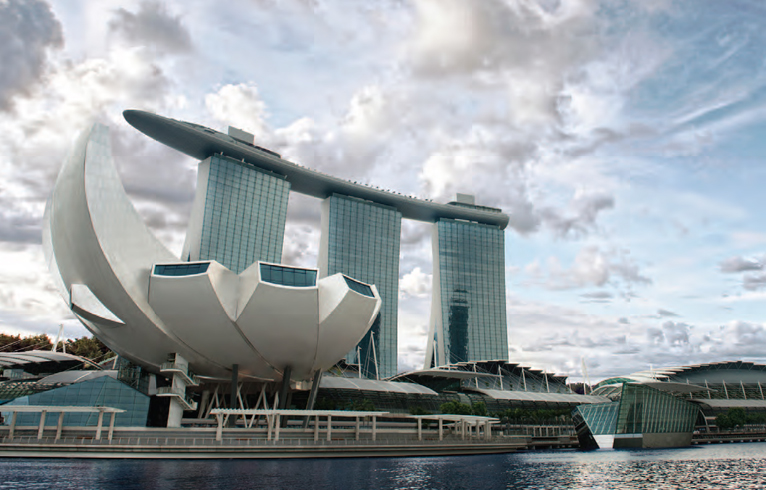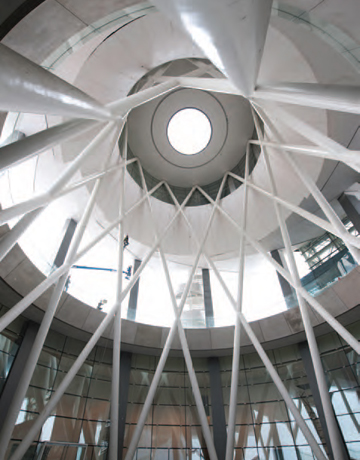A NEW MUSEUM FOR SINGAPORE
| April 21, 2011 | Post In LEAP 8

Like a white lotus in full bloom on a pond’s surface, the ArtScience Museum glitters under the clear Singaporean skies. Situated in front of the three towers of Marina Bay Sands and next to the winding silvery strands of the Helix Bridge, the museum adds to an already striking skyline in the new waterfront area of Marina Bay.

The museum was designed by renowned architect, educator, and urban planner Moshe Safdie, who worked on the refurbishment of Old Jerusalem. Metaphors for the structure’s external appearance abound. Press materials christen the building’s ten finger-like protrusions “The Welcoming Hand of Singapore.” Cheekier locals have dubbed it a bunch of bananas. (During the opening ceremony, Las Vegas Sands Corp. chairman Sheldon Adelson quipped, “Luckily we didn’t paint it yellow!”) Of course, the actual intended reference is a lotus flower. In the end, though, most everybody agrees: that there are a number of metaphors for this landmark isn’t a bad thing.
As far as Safdie is concerned, however, the robust sculptural feeling of this “lotus” owes simply to the conjoining of curved surfaces, the pure perfection of mathematical beauty. In fact, this “beauty” made building the structure all the easier. Also adding to the lotus connotations is a 4,000 square meter pond which adorns the building’s plinth. The reflections it throws off work to unite not only the museum building, but the towers behind it, with their surroundings. Sitting by the pond, one can feel Safdie’s gift for pulling spaces together.
ArtScience Museum formally opened in February of this year, alongside the opening of Marina Bay Sands, Las Vegas Sands gambling corporation’s first project in Singapore. This ambitious project is comprised of a hotel, shopping mall, conference center, casino, theater and the museum. Including the cost of the land, total investment reached USD 5.5 billion. As per the stringent restrictions set by the Singaporean government, the casino does not cover more than two percent of total area. Building a museum was one of the prerequisites for receiving government support.

Whether it’s the government, Sands, or Safdie, it seems that everybody likes to make mention of Frank Gehry’s Guggenheim in Bilbao. For the local government, obviously, the foreign investment, increased number of international visitors, new local landmark, and success on the part of a celebrity architect are all elements necessary to carry out its great plan to create a new cosmopolitan metropolis of the East Asian and Arab Worlds, no matter if the government’s ears are still ringing from its critics— Singaporeans who didn’t want to see two international gambling houses (the other is Malaysia’s Genting Highlands) enter the country within just a few short years. On the other hand, in the opening press conference, Adelson was already enthusiastically discussing a “second phase,” as well as further marine reclamation. When a reporter asked how much land he still hoped to annex from Singapore, he didn’t hesitate in the slightest: “The more the merrier.”
It’s been said that Prime Minister Lee Hsien Loong announced that the date for the museum’s opening ceremony was chosen in accordance with the advice of a fengshui master. The three historically themed exhibitions of the opening phase also revealed a serious interest in Asian history and Sino-Western relations on the museum’s part. The show “Genghis Khan: The Exhibition,” which deals in the Mongolian leader’s straddling of Asian and European empires by way of the Silk Road and Maritime Silk Road, certainly isn’t the best example of the kind of innovative museum ArtScience is (the permanent exhibition “ArtScience: A Journey Through Creativity” is a more faithful representation), but in the commercial and globalized context of today, these exhibitions offer that much more ample and inspiring content for interpretation. If we go ahead and consider Singapore’s position in the Strait of Malacca, and its importance to oceanic trade, the exchange of goods, and the fusion of cultures, the discursive thrust of these exhibitions starts to make more sense.

